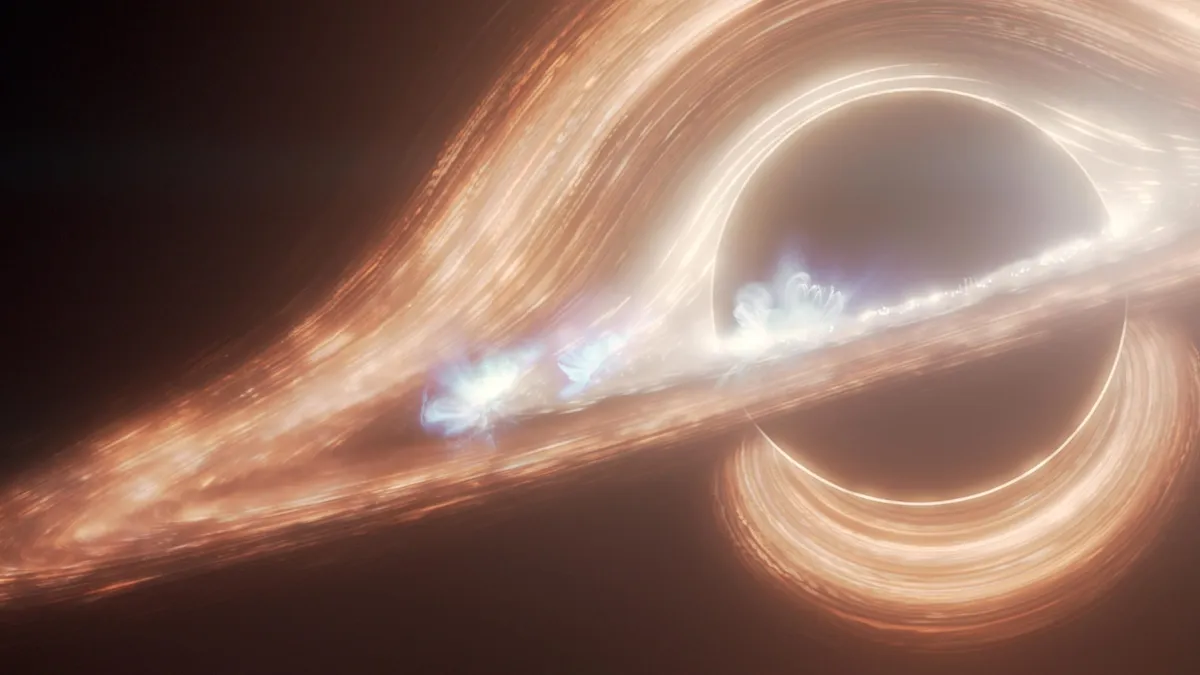
The supermassive black hole at the center of the Milky Way is putting on a relentless light show. Using NASA’s James Webb Space Telescope, a team of astrophysicists has captured the most detailed and extended observation yet of Sagittarius A*, the mysterious “void” lurking at the heart of our galaxy.
Their findings reveal that the swirling disk of gas and dust surrounding Sagittarius A* — known as the accretion disk — is continuously flaring with no breaks. These flares vary in intensity and duration, ranging from brief, faint flickers lasting seconds to powerful, blinding eruptions occurring daily. Some even shift subtly over months, creating a dynamic and unpredictable display.
This discovery could provide new insights into the fundamental nature of black holes, how they gather material from their surroundings, and how such processes shape the evolution of our galaxy. The study was published in the February 18 issue of The Astrophysical Journal Letters.
“In our data, we saw constantly changing, bubbling brightness,” said Farhad Yusef-Zadeh of Northwestern University in Illinois, who led the study. “And then boom! A big burst of brightness suddenly popped up. Then, it calmed down again. We couldn’t find a pattern in this activity. It appears to be random. The activity profile of this black hole was new and exciting every time that we looked at it.”
To conduct the study, Yusef-Zadeh and his team used Webb’s NIRCam (Near-Infrared Camera) to observe Sagittarius A* for a total of 48 hours in 8- to 10-hour increments across one year. This enabled them to track how the black hole changed over time.
While the team expected to see flares, Sagittarius A* was more active than they anticipated. The observations revealed ongoing fireworks of various brightnesses and durations. The accretion disk surrounding the black hole generated five to six big flares per day and several small sub-flares or bursts in between.
Although astrophysicists do not yet fully understand the processes at play, Yusef-Zadeh suspects two separate processes are responsible for the short bursts and longer flares. He posits that minor disturbances within the accretion disk likely generate the faint flickers. Specifically, turbulent fluctuations within the disk can compress plasma (a hot, electrically charged gas) to cause a temporary burst of radiation. Yusef-Zadeh likens these events to solar flares.
“It’s similar to how the Sun’s magnetic field gathers together, compresses, and then erupts a solar flare,” he explained. “Of course, the processes are more dramatic because the environment around a black hole is much more energetic and much more extreme. But the Sun’s surface also bubbles with activity.”
Yusef-Zadeh attributes the big, bright flares to occasional magnetic reconnection events — a process where two magnetic fields collide, releasing energy in the form of accelerated particles. Traveling at velocities near the speed of light, these particles emit bright bursts of radiation.
“A magnetic reconnection event is like a spark of static electricity, which, in a sense, also is an ‘electric reconnection,’” Yusef-Zadeh said.
Because Webb’s NIRCam can observe two separate wavelengths at the same time (2.1 and 4.8 microns in the case of these observations), Yusef-Zadeh and his collaborators were able to compare how the flares’ brightness changed with each wavelength. Yet again, the researchers were met with a surprise. They discovered events observed at the shorter wavelength changed brightness slightly before the longer-wavelength events.
“This is the first time we have seen a time delay in measurements at these wavelengths,” Yusef-Zadeh said. “We observed these wavelengths simultaneously with NIRCam and noticed the longer wavelength lags behind the shorter one by a very small amount — maybe a few seconds to 40 seconds.”
This time delay provided more clues about the physical processes occurring around the black hole. One explanation is that the particles lose energy over the course of the flare — losing energy quicker at shorter wavelengths than at longer wavelengths. Such changes are expected for particles spiraling around magnetic field lines.
To further explore these questions, Yusef-Zadeh and his team hope to use Webb to observe Sagittarius A* for a longer period of time, such as 24 uninterrupted hours, to help reduce noise and enable the researchers to see even finer details.
“When you are looking at such weak flaring events, you have to compete with noise,” Yusef-Zadeh said. “If we can observe for 24 hours, then we can reduce the noise to see features that we were unable to see before. That would be amazing. We also can see if these flares repeat themselves or if they are truly random.”
Explore Further: NASA’s Webb Captured Something Strange Happening at the Heart of Our Galaxy
Reference: “Nonstop Variability of Sgr A* Using JWST at 2.1 and 4.8 μm Wavelengths: Evidence for Distinct Populations of Faint and Bright Variable Emission” by F. Yusef-Zadeh, H. Bushouse, R. G. Arendt, M. Wardle, J. M. Michail and C. J. Chandler, 18 February 2025, The Astrophysical Journal Letters.
DOI: 10.3847/2041-8213/ada88b
The James Webb Space Telescope (JWST) is the most advanced space observatory ever built, designed to explore the universe’s deepest mysteries. As NASA’s flagship space telescope, in partnership with ESA (European Space Agency) and CSA (Canadian Space Agency), Webb is revolutionizing our understanding of the cosmos. It investigates our solar system, studies exoplanets orbiting distant stars, and peers into the early universe, uncovering the origins of galaxies and cosmic structures. With its powerful infrared capabilities, Webb is providing unprecedented clarity and detail, helping scientists explore our place in the vast expanse of space.